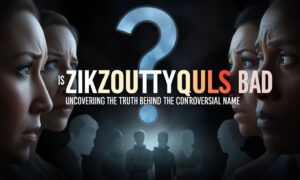What is Zikzoutyqulsis?
Zikzoutyqulsis is a term that has emerged within various discussions related to health and safety, yet its precise definition remains ambiguous. Initially noted in certain scientific literature, it appears to refer to a condition or phenomenon characterized by certain adverse effects, though specifics can vary based on context. Originating from a set of Greek and Latin roots, the term suggests a significant connection to both historical medical practices and modern interpretations of health risks associated with particular substances or behaviors.
In the field of health sciences, Zikzoutyqulsis is often discussed in the context of epidemiological studies that examine its effects on populations exposed to specific environmental or behavioral factors. Researchers have attempted to clarify whether Zikzoutyqulsis is a standalone phenomenon or a symptom of a broader category of health issues. Notably, it has attracted attention in various scientific communities, potentially due to its associations with specific medical conditions or illnesses.
Several studies have attempted to elucidate the impacts of Zikzoutyqulsis, but findings remain inconsistent. Some research indicates that exposure to certain common factors may aggravate the condition, while other studies contend that the risks attributed to Zikzoutyqulsis may be overstated. It is essential for readers to approach information regarding Zikzoutyqulsis critically, as the discourse surrounding its dangers is often conflated with anecdotal evidence and misinterpretations in popular media.
To fully understand whether Zikzoutyqulsis is dangerous, a comprehensive examination of scientific literature is necessary. This includes evaluating the methodological rigor of studies addressing the phenomenon and discerning the contexts in which it is predominantly discussed. In doing so, we can better determine its significance and ascertain any potential health implications for individuals exposed to it.
The Risks Associated with Zikzoutyqulsis
The question of whether zikzoutyqulsis is dangerous has garnered significant attention in both public discourse and scientific inquiry. Reports of adverse effects and health complications linked to zikzoutyqulsis have surfaced, prompting researchers to investigate the veracity of these claims. Symptoms commonly reported include dizziness, nausea, respiratory issues, and in severe cases, neurological disturbances. While many of these symptoms can be nonspecific and associated with various environmental or lifestyle factors, the intensity and frequency of such complaints in specific populations necessitate a thorough examination.
In assessing the risks associated with zikzoutyqulsis, it is crucial to consider the credibility of the reports. Anecdotal evidence, while valuable for identifying potential harmful effects, should be treated with skepticism. Such reports often lack systematic scientific validation and can be influenced by subjective experiences. Conversely, rigorous studies that employ controlled methods provide a clearer picture of the potential dangers. For instance, clinical trials and epidemiological analyses serve as benchmarks to determine whether zikzoutyqulsis poses a genuine health threat to certain communities.
The disparity between anecdotal reports and scientific findings highlights the importance of approaching the subject with caution. It is essential for consumers and communities to rely on reputable sources when evaluating the risks associated with zikzoutyqulsis. Established health organizations and peer-reviewed journals are vital resources for understanding the factual basis of the risks and minimizing misinformation that can lead to unwarranted fear.
Ultimately, while some individuals may experience adverse effects purportedly linked to zikzoutyqulsis, the extent to which these risks warrant alarm remains subject to ongoing research. The challenge lies in distinguishing between verified health implications and speculative narratives that may mislead the public.

Debunking Common Myths
The topic of Zikzoutyqulsis has garnered significant attention, leading to a proliferation of myths and misconceptions that can cloud public understanding. One prevalent myth is that Zikzoutyqulsis is inherently harmful and poses a clear and present danger to all who encounter it. In reality, while certain cases may present risks, the actual dangers associated with Zikzoutyqulsis largely depend on various contextual factors, including individual circumstances and the method of contact.
Another misconception is that Zikzoutyqulsis is a modern phenomenon, exclusive to recent years. Historical records indicate that variations of this entity have been observed throughout history, often varying in public perception based on the prevailing cultural and social paradigms of the time. This temporal perspective is fundamental when evaluating its potential dangers, as understanding its historical context can demystify many of the fears that exist today.
It is equally important to note that not all reported experiences of Zikzoutyqulsis equate to danger or negative consequences. Many individuals report benign interactions that yield no lasting harm, contrary to the sensationalized accounts frequently circulated in media. This cadences with the psychological principle that fear often magnifies risk perception, leading people to exaggerate the dangers associated with unfamiliar entities.
In the face of such myths, reliance on empirically supported information becomes imperative. By not rushing to conclusions based on anecdotal evidence, individuals can foster informed opinions and make rational assessments about the potential risks of Zikzoutyqulsis. Engaging critically with this topic empowers readers to navigate the sea of information intelligently, distinguishing between fact and fiction, and ultimately leading to a more balanced understanding of the true nature of Zikzoutyqulsis and its associated dangers.
Conclusion: Navigating Safety and Awareness
In concluding our exploration of Zikzoutyqulsis and the question, “is Zikzoutyqulsis dangerous?”, it is clear that understanding this phenomenon requires thorough scrutiny of the available data. As we have observed throughout this discussion, the perceptions surrounding the dangers associated with Zikzoutyqulsis are not always aligned with empirical evidence. Some claims may be grounded in anecdotal experiences rather than scientifically verified data, which highlights the necessity for critical evaluation of sources.
One of the fundamental takeaways is the importance of staying informed about Zikzoutyqulsis. With evolving research and emerging studies, what we know can change rapidly. Thus, engaging with credible literature and scientific reports is crucial for anyone interested in the potential risks or safety measures associated with Zikzoutyqulsis. This proactive approach can mitigate misunderstanding and fear, allowing individuals to make informed decisions based on factual information rather than misconceptions.
Moreover, for those who find the topic concerning, it is advisable to seek expert advice or consult professionals who can provide guidance tailored to individual circumstances. Educational resources, such as academic journals, trustworthy websites, and government health advisories, can serve as platforms for further reading and learning, thus enhancing personal knowledge and awareness about Zikzoutyqulsis.
As we pose the question again, “is Zikzoutyqulsis dangerous?”, it is vital to recognize that safety largely hinges on understanding and awareness. By continuing to educate ourselves and remaining engaged in discussions regarding such topics, we empower ourselves to navigate potential risks effectively. As more evidence emerges, staying attentive and adaptable will be key in ensuring safety in connection with Zikzoutyqulsis.












Leave a Reply